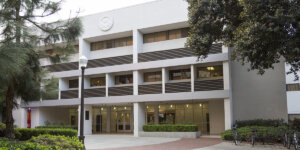
USC Viterbi Ph.D. graduate Ali Marjaninejad works at the cutting edge of biology and engineering as a postdoctoral research associate in the Valero Lab.
Originally from Tehran, Iran, Marjaninejad completed his M.S. in Electrical Engineering and Ph.D. in Biomedical Engineering at USC Viterbi. His work includes a robotic limb with tendons, which is able to be tripped up and can recover almost immediately—research that was published in Nature Machine Intelligence.
USC Viterbi spoke to Marjaninejad about how he got his start in the fascinating field of biological and bio-inspired systems and robotics.
Tell us about what you do.
My research links biological systems, artificial intelligence (AI) and engineering. I get inspired by biology—neuroscience, biomechanics, etc.—to come up with AI and other engineering solutions. I also use engineering techniques to work with and to better understand biological systems, which makes it a complete cycle back and forth between biology and engineering. I focus on two specific lines of research:
- Bio-inspired systems where we build hardware and software combinations that mimic biological systems in their enviable physical agility and mental learning abilities and consciousness.
- Biological signal processing and pattern recognition, especially Brain-Machine Interface (BMI) devices where we record and utilize human biological signals—recordings from the brain and muscles etc. These signals can then be processed and used to control a wide set of devices and applications, such as robotic prostheses.
What excites you most about your research?
I was always fascinated by magic when I was younger. Alas, it didn’t take me too long to realize that there is no such a thing as magic, but I realized that science is the closest thing to magic that we can use in the real world.
I am excited about the work we do in studying neuromechanics and biomedical signal processing since it can help people with disabilities to perform their everyday tasks independently. I am interested in autonomous systems in general and robotics in particular since it can make our everyday lives easier through automation and ultimately provide us with abundance, such as mechanization in resource production and gathering, and safety, by performing tasks that are dangerous for humans.
My ultimate professional goal is to use this “magical” power to make the world a better place to live for all humans.
When did you first know you wanted a career in engineering and what drove you toward biological and bio-inspired systems?
I believe that I was the most curious person in my family. I used to open all the electronics to find out how they work. After breaking at least half of the electronics in our house, I finally started to put this curiosity to good use—I started to help family and friends by fixing their electronics and gadgets. I pursued a career in engineering which equipped me with many skills and provided me with solid understanding in physics, math, and electronics which further helped me to understand different concepts and to find the answers to quench my curiosity.
It was in the anatomy class during my undergraduate school that I first started to wonder how exactly our bodies and brain work. That is when I realized that there is much one can learn from biology that can be applied to engineering.
What first drew you to robotics, in particular robotics for biomedical applications?
Engineering in general, and AI in particular, have made much progress in recent years. For example, AI can now help us by recognizing faces in pictures and categorizing them in our phone gallery or can provide us with the list of the books we are more likely to enjoy based on our reading history. However, we do not see such progress when it comes to interactions of engineered systems with the physical world. Although AI can now help us tremendously in computations, its abilities are still very limited within the tasks that need physical interactions within the unstructured and unpredictable environments humans live and work in. That is why I am very interested in closing this gap by developing robots that can learn, act, and adapt safely and efficiently across different environments and scenarios, including the ones with human interactions. An example of such a system in the biomedical field is to build bio-inspired, smart prosthetic devices that can learn from its user’s habits and adapt to its personal needs and activities. Another example of these systems that we are working on would be bio-inspired four legged robots that can learn and adapt on-the-go to help us with rescue missions which includes environments that would be highly unpredictable.
What were some highlights of your time completing your studies at USC Viterbi?
I was extremely honored to be one of the few (if not the only) student in the USC Viterbi school of engineering to receive both of the Best Research Assistant and Jenny Wang Excellence in Teaching awards at the same time. I was deeply honored to receive the excellence in teaching award but I think it is mainly just because I had the opportunity to learn from the very best of mentors and work with the amazing students here at USC.
As for the Best Research Assistant award, I want to take a few minutes and walk you through the last few years of my research journey:
During 2018, my Ph.D. advisor and I came up with a crazy idea! What if we can have a robotic leg that uses tendon-driven structure, similar to biological systems, and can learn how to move all by itself? This would be a big contribution in both the design and the learning aspect of the current state-of-the-art in robotics that would significantly improve their abilities and the ways in which they can help us. This was an ambitious goal because controlling tendon-driven systems remains challenging and most of the current state-of-the-art work uses traditional clumsy robotic structures—placing motors at each joint. Also, traditional autonomous learning approaches mostly use control strategies that are engineered for a specific system or scenario, or highly depend on very large, pre-recorded datasets which limits their generatability and applications to many real-world problems. Our approach would enable robots to learn with minimal information about the physics of their body or their environment and adapt on the go to new scenarios, just like juvenile vertebrates!
In 2019, in collaboration with Darío Urbina-Meléndez, Dr. Brian Cohn, and my Ph.D. advisor, Professor Francisco Valero-Cuevas, and with the generous support of NIH and DARPA, we successfully completed this project and published it in the prestigious journal, Nature Machine Intelligence. It had ground-breaking contributions and applications to a wide range of fields including AI, Biomechanics, Robotics, and Neuroscience. We are currently working on advancing the abilities of these robots so that they can help us with different tasks such as search and rescue, space exploration, and working in environments that are too dangerous for humans, where they can learn quickly with minimal prior information and adapt to unpredicted situations on the go.
Did you have any mentors or role models who helped you along the way?
Indeed! I would like to express my strongest gratitude to my mentor and advisor, Professor Francisco Valero-Cuevas, who was there for me during this adventurous journey to share his insight and provide his support, whenever I needed it. He taught me through example how to be a good engineer, a good scientist, and most importantly, a good human being.
Published on November 15th, 2021
Last updated on November 15th, 2021











